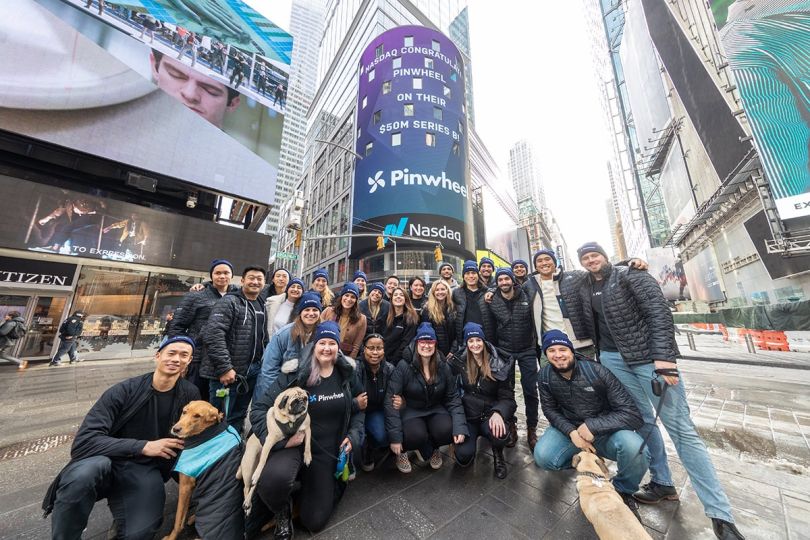A toddler gleefully waddles along, unafraid as they stumble and fall, barely wincing as they rise again with scraped knees. A kindergartener beams with pride at their scribbled-on coloring book, regarding every stroke outside the lines as a masterpiece worthy of the Louvre.
Yet for too many, adulthood is synonymous with a colorless, risk-averse daily grind: Wake up. Coffee. Emails. Meetings. More coffee. This kind of lackluster mentality does not lend itself to the inventive ideas and lightbulb moments that both employers and employees yearn for.
Companies where creativity and curiosity are king know that innovation does not happen by chance; it takes intentional planning across an organization’s systems, leadership and hiring, along with an openness to diverse viewpoints. Sometimes, fostering innovation in the workplace even means tapping into an employee’s inner child.
“Innovative companies remind their people of the wonder they experienced as children and the confidence they had to play and learn,” said Gary Fosko, executive director of IT talent enablement at Merck.
For other companies, sparking creativity means hosting hackathons, shaking up the hiring process or setting aside days for employees to work on their own passion projects. Built In checked in with five New York-area companies about how they disrupted day-to-day drudgery in their workplaces by encouraging employees to explore and think outside the box.

For Pinwheel, a payroll connectivity API company, a culture of innovation begins with hiring people with diverse viewpoints and then ensuring those employees feel safe to voice new ideas.
What are some signs that a company actually has a culture of innovation? What does that look like in practice?
Because culture is organic, fostering innovation as a part of culture starts first and foremost with the people on the team. Companies that are innovative hire with the intention of leveling up their culture with every new employee. The most common pitfall in hiring is when a manager tends to hire those who are similar to themselves. This hiring practice can lead to linear thinking rather than fostering thought diversity — and by virtue of diversity, innovation.
The second step beyond the “who” is creating a safe space for innovation to flourish. Executive buy-in must be viewed as the default state with respect to employees exploring innovative work. Any time an idea is shot down without exploration, the culture retracts and innovation is stymied.
It is important to help incentivize people away from exclusively consuming work that is handed to them and thinking no further beyond it.”
Culture is something every employee contributes to. How do you personally make space for new ideas and innovative ways of doing business?
I make space for new ideas in two key ways. First, I never present myself, my work or any work the company does as immutable. I solicit challenges and feedback from every decision I make and ensure I always take time to think critically about any feedback given. This is key because if feedback is brushed off, it will dry up.
Second, I always tell people I work with to regularly force themselves to take a step back and ask themselves the question, “What should we be doing?” The intent of the question is for the person to remove themselves from their job and its day-to-day responsibilities and then answer the question. It’s actually a tough exercise, as it is easy to get caught up in tasks and day-to-day work, the familiarity of the work and the routine that come along with it. It is important to help incentivize people away from exclusively consuming work that is handed to them and thinking no further beyond it. That is where innovation starts.
What are some of the challenges your company has faced in developing or maintaining this type of culture, particularly as you’ve grown? How did you overcome those challenges?
Holding the hiring bar through periods of aggressive growth is very hard. It’s very attractive to accept “good enough” and get a body in a seat rather than hold out for the culturally additive individual mentioned above. We structure our interviews in ways that remove the responsibility of this evaluation from the team who is doing the hiring. We call it a bar raiser interview, and it typically falls on our CEO. This has allowed us to overcome the challenge of holding the line and diluting our culture.
At Merck, a biopharmaceutical company, leaders don’t schedule “Innovate now” on their calendars. Instead, they believe innovation happens by encouraging employees to explore their child-like wonderment and shake up their routines.
What are some signs that a company actually has a culture of innovation?
Companies that approach culture using the practices of anthropology, biology and sociology have the best signs of innovation in my experience. This means experimenting with new rituals, using new language, building creative confidence and focusing on the source of innovation: people as innovators.
People in innovative cultures have the confident, curious mindset of “I wonder what would happen if we…” and then they experiment. One of the experiences everyone in a culture shares is that of being a child. Innovative companies remind their people of the wonder they experienced as children and the confidence they had to play and learn. Lastly, innovative cultures have a way of noticing who’s missing from a conversation and including diverse talents before taking action on an idea.
How do you personally make space for new ideas and innovative ways of doing business?
My experiences being innovative are largely unplanned and opportunistic. I’ve never had a meeting on my calendar called “Innovate now.” It’s the random idea that’s sparked by taking an unplanned walk in a new place, talking to someone with beliefs different than mine, trying something new that makes me uncomfortable, reading a new book or driving home a new way, blasting new music. These experiences disrupt my default ways of thinking and help make new connections between problems and solutions.
I also have up to three experiments underway at any given time, creating a laboratory of learning often with surprising results. As an example, I learned years ago that your handwriting is your most powerful font to communicate with. I started handwriting certain messages to people and encouraging others to do so. One day, our CEO at the time was visiting our site and asked me what he could do for our people. I asked him to handwrite a message of gratitude to our teams and remind them to take care of themselves. I gave him a Sharpie and a big poster board. He leaned it against the wall and in two minutes, he wrote a sincere message that our people were so thankful for. That handwritten message from our CEO would not have been as powerful as an email.
For Onna, a knowledge integration platform, fostering workplace innovation looks like hosting hackathons and setting aside days for employees to pursue their passion projects.
What are some signs that a company has a culture of innovation?
A key indicator of a culture of innovation is when people are willing to take chances and freely express ideas or creative solutions. There has to be acceptance for diverse opinions and outside-the-box thinking, as well as strong collaboration and inclusion when developing those ideas.
Another indicator is an acceptance of fast failure — the idea that you can try something, iterate and come to a conclusion quickly, without being penalized if it fails. Having such rigorous processes that enforce a 100 percent success rate won’t foster innovation.
To create a culture of innovation, you first have to give people the opportunity to demonstrate innovation, and this could include innovating products, processes or entire business models. Opportunities might be things like hackathons or allocating a day per month for teams to focus on their own passion projects at work.
Then, you have to allocate time and resources to advance the best ideas, backed by executive sponsorship. For example, at Onna, we’ve made forward hires to focus on long-term projects extending a couple years out. We know that to get where we want to go in the future, we need to start innovating in certain areas right now.
How do you make space for new ideas and innovative ways of doing business?
One of the things I do is measure and reward employee and team business impact because business impact lends itself to innovative solutions versus incremental solutions. Rather than rewarding people for what they already do well, reward people for their ability to do things better and for breakthrough gains in performance.
I also encourage Skunk Works projects where teams are empowered to spend time developing their own ideas and then bring them to the organization to be funded.
I am open to leveraging other technologies. Not everything has to be built by us, and we can leverage other companies’ solutions to support innovations and build intellectual property of our own as extensions to the core technology. Great examples of this include the application of machine learning algorithms to domain-specific challenges.
Lastly, I try to make sure we stay focused on delivering value for our customers. Innovative companies listen to what customers are asking for and find solutions to their challenges, which often leads to greater innovation. Something I’ve seen work well is creating customer innovation programs where you co-innovate with customers to apply technology to solve business problems.
Rather than rewarding people for what they already do well, reward people for their ability to do things better.”
What are some of the challenges your company has faced in developing or maintaining this type of culture?
It can be difficult to maintain a culture of innovation when you start growing and adding hierarchy and more teams. This creates complexity and silos, where you can lose some of the cross-functional dependencies and collaboration that are so important for fostering innovation. As a result, teams can become hyper-focused on what’s immediately in front of them, instead of thinking bigger.
This is a hard thing to tackle, but some of the tools mentioned earlier — like hackathons, monthly days off for ideation and providing opportunities for teams to demonstrate their ideas and secure executive sponsorship for the best ones — are key ways to address this gap. Something else that can help is to carve out funds specifically for innovation projects, like developing customer innovation programs or building product innovation teams where we can organize ourselves better to progress new ideas.
As your business matures and as more hierarchy and silos emerge, it’s important to think about how you organize your innovation culture in this new context to ensure you’re maintaining a cross-collaborative and multi-team-enabled approach.

Driven by its belief that in-person collaboration works best, adMarketplace reopened its doors in July 2021. The search advertising marketplace recently trained managers on the value of asking open-ended questions, hoping to create a more vulnerable, innovative workplace.
What are some signs that a company has a culture of innovation?
Across our organization, we ask ourselves: How can we create search experiences that are relevant and useful, while protecting consumer privacy? We know our culture of innovation is working when our team takes calculated risks to overcome challenges to deliver on our mission.
When our innovative culture risks pay off, we achieve triple-digit growth by building partnerships with the world’s largest brands, and our team grows their careers.
We look for ways to turn our culture of innovation into a culture of opportunity.
In practice, a well-defined culture allows us to understand the needs and the cultures of our partners. We know most companies are trying to figure out how to go remote, yet we know we play the game at the highest level in person. Personal connection underlies our values, what we call the 5 C’s — curiosity, creative conflict, collaboration, commitment and competitiveness — which all work best when we’re not interacting via screen.
How do you personally make space for new ideas and innovative ways of doing business?
We foster an innovative environment by building the trust and safety that allows for honest, open communication. We value the diverse experiences and skills each adMarketplace team member brings, and it’s important that everyone feels comfortable asking questions and sharing their ideas.
We recently rolled out a manager training program for more than 35 employees that focused on asking open-ended questions. This is a crucial skill that requires vulnerability for new managers, and we want them to practice and teach that skill to their direct reports.
We know growth happens when we are outside of our comfort zone. We don’t allow ourselves to get comfortable or let things stay the same for too long, especially when something is not working. It’s about welcoming new learning, staying flexible in our approach, pivoting when necessary and always tackling any challenges head-on.
The adMarketplace team attracts people who lean into the company culture with a growth mentality. They’re ready to show up, compete and attract others with a similar mindset.
What are some of the challenges your company has faced in developing or maintaining this type of culture?
While many organizations and businesses pivoted to remote-first, the adMarketplace team firmly believed that in-person collaboration was the best way to innovate, learn and grow as a team. That’s why adMarketplace was one of the first companies to return to our offices, once we were able to do so safely.
Since returning to the office, we have implemented upgraded HEPA filters in the HVAC system, vaccine mandates and, most recently, a booster incentive program that supports face-to-face collaboration in this new work environment. The mental health gains of engaging in person cannot be overlooked.
As one of the first companies to implement a back-to-office strategy in July 2021, we’ve made mistakes along the way. Our culture allowed us to learn and grow and as a result, our organization became stronger.

SIMON, a fintech company, regards innovation as part of its DNA. The company hosts a weekly innovation committee and annual hackathons.
What are some signs that a company actually has a culture of innovation?
A company fosters a culture of innovation with two important components. First, to believe that innovations and great ideas can come from anyone in the organization, bypassing hierarchies and even role definitions. Second, to provide a forum for employees to develop their ideas, which can then be evaluated as potential.
SIMON supports two programs that encourage all employees to cultivate innovation and provide them with the actual framework to accomplish it. First is our active innovation committee. The committee meets weekly and brings together our “innovation champions” who serve as representatives from different teams at SIMON. Innovation champions can be senior or junior members, and their roles are to propose and surface ideas from their respective teams for the purpose of translating them to real initiatives.
Second is our annual Hackathon Day, when the entire company steps back from their day-to-day tasks, forms multi-discipline teams and works together to bring innovative ideas to life. Hackathon teams submit final projects that are evaluated by SIMON’s innovation committee on a variety of factors, including feasibility and detailed analysis, for hackathon awards.
How do you personally make space for new ideas and innovative ways of doing business?
I like to look at every new project or initiative as an opportunity to improve and reiterate. People at SIMON are open and receptive to hearing about new ideas and concepts, which drives me to push my work even further. Of course, we all have specific tasks to complete, but being proactive and introducing new ideas is a creative approach at SIMON that generates results.
There are numerous times when I’ve witnessed people take the time to propose new ideas and methods, which have then translated to an implemented solution. That solution then ultimately delivers process improvements or a better end result for everyone.
I feel the people at SIMON are extremely imaginative and genuinely seek ways to innovate in their day-to-day jobs, knowing the company will be receptive and willing to invest in a good idea. Ultimately, that is what sets SIMON apart in having a true culture of innovation.
What are some of the challenges your company has faced in developing or maintaining this type of culture, particularly as you’ve grown?
SIMON has grown from around 30 employees to 200, and our platform is now available to more than 100,000 financial advisors. It has been an exciting journey. One of the biggest challenges for a fast-growing fintech company is devoting time to focus on innovation projects when there is so much that needs to be done. However, innovation is part of SIMON’s DNA, and the innovation committee and the hackathon initiative are two examples that exemplify SIMON’s commitment to innovation by officially allocating time and providing the collaborative setting for employees to cultivate creativity. It is truly the people at SIMON that help drive this innovation culture through their intellectual curiosity and passion.
I was fortunate enough to be part of the SIMON Spectrum team. SIMON Spectrum is our new allocation analysis framework and portfolio construction tool, and one of the company’s flagship innovations. The project started with a small group of people. It was not an official business line at the time, just an idea! The commitment and devotion from management and the employees to evolve Spectrum into a real product offering is a perfect example to showcase SIMON’s true commitment to innovation.














